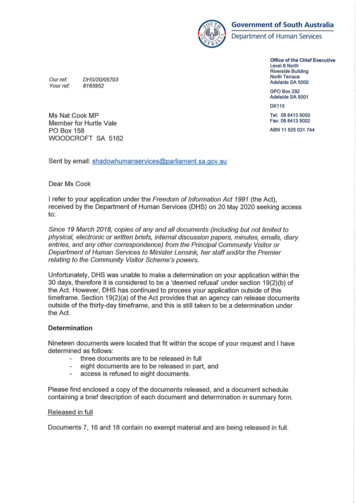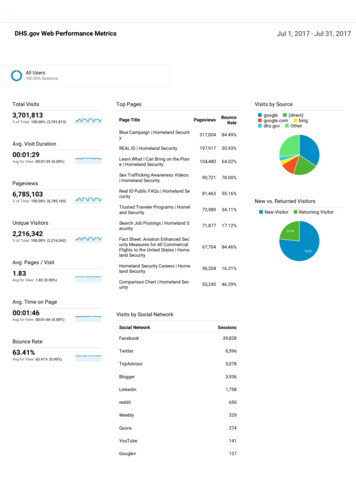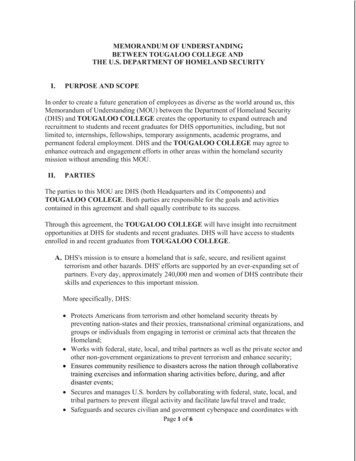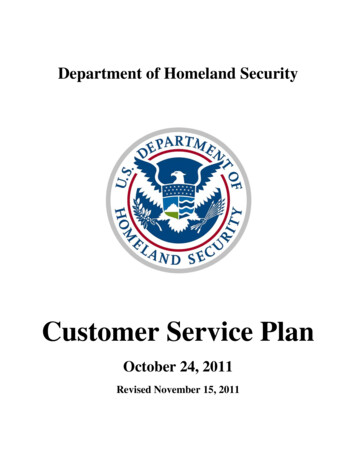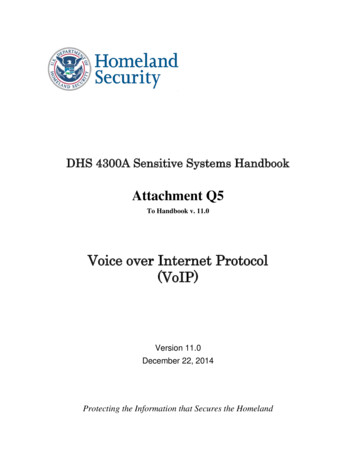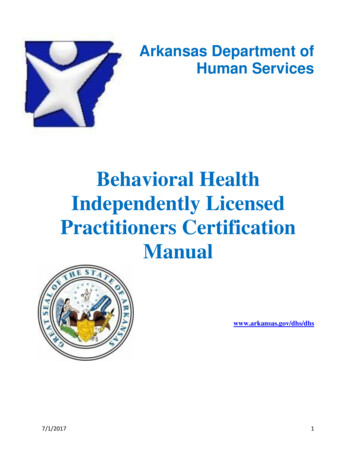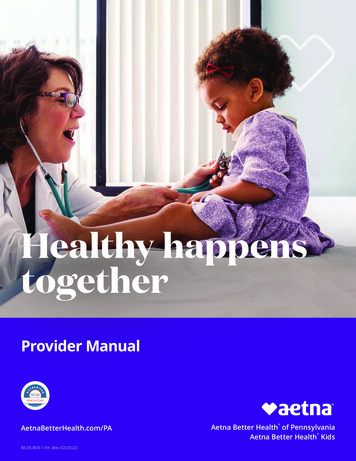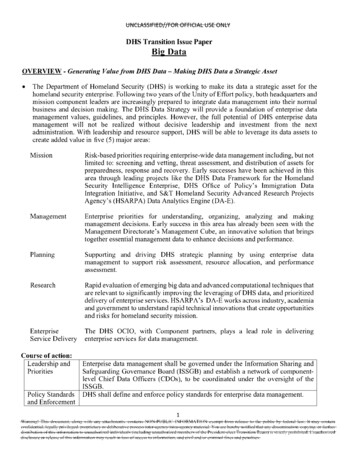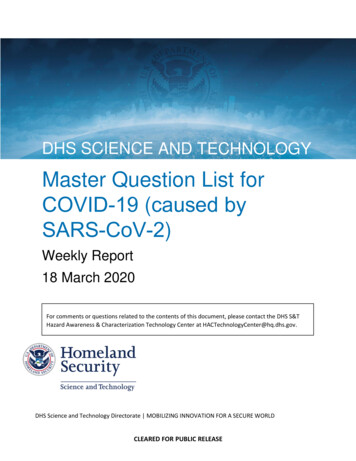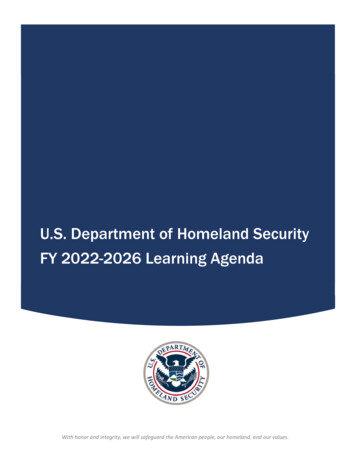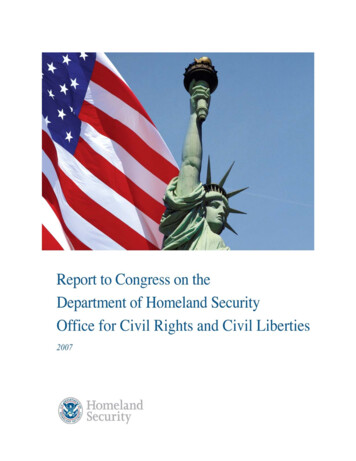
Transcription
BACKGROUND AND SUMMARY . 1CRCL PROGRAMS. 3I.Individuals with Disabilities and Other Special Needs Populations in EmergencyPreparedness . 3A. Implementation of Executive Order 13347, Individuals with Disabilities in EmergencyPreparedness . 3B. Development of Guidelines for Accommodating Individuals with Disabilities in Disaster. 4C. The National Response Plan and National Incident Management System Revision. 4D. Special Needs Planning Guide. 5E. FEMA Disability Coordinator. 5F. FEMA Application/Registration for Disaster Assistance .6G. Emergency Preparedness Exercises . 6H. Collaboration with American Red Cross, Salvation Army and other Volunteer OrganizationsActive in Disasters . 6I. Outreach Activities . 7II.Engagement with American Arab, Muslim, Sikh, Middle Eastern, and South AsianCommunities. 7A. Formal Meetings with Advocacy Groups, Community Leaders, and Senior DHS Officials . 8B. Conferences, Media Appearances, and Significant Events. 9C. Incident Community Coordination Team: Arab, Muslim, Sikh, South Asian, and MiddleEastern American Communities . 11III.Immigration Initiatives. 11IV.Civil Liberties Institute. 12V.Office on Accessible Systems & Technology. 14A. Web Audit and Remediation Program . 14B. Implementation of a Commercial/Government Off-the-Shelf accessibility/Section 508evaluation and integration service . 14C. Accessibility Help Desk . 14VI.Intelligence Community Activities and Information Sharing . 15VII.Legislative Activities . 15COMPLAINT INVESTIGATIONS. 18I.CRCL Complaint Process . 18
II.Summary of Complaints Received Under CRCL Statutes . 19III.Examples of Complaints Resolved by CRCL. 20A. Treatment of Unaccompanied Minors . 20B. Customer Access to Sign Language Interpreters – U.S. Citizenship and ImmigrationServices (USCIS) . 20C. Traveler Redress Inquiry Program . 21D. Conditions of Detention for Adult ICE Detainees . 21E. Reasonable Accommodations for Persons with Disabilities at the Border . 22F. Religious Accommodations for DHS contract employees . 22G. Reasonable Accommodations for Persons with Disabilities in Requesting DisasterAssistance . 22EQUAL EMPLOYMENT OPPORTUNITY . 23I.EEO Complaint Program Management . 24A. Providing Leadership to Component EEO and Civil Rights Offices in EEO ComplaintProcessing . 24B. Effective Processing of Final Actions in EEO Complaints. 25C. Proactive EEO Compliance Program. 25II.EEO Program Evaluation . 25III.Training . 26IV.Commitment to Hiring People with Disabilities . 26V.Headquarters Equal Employment Opportunity . 27CONCLUSION . 29ACRONYMS . 30
BACKGROUND AND SUMMARYIn accordance with 6 U.S.C. § 345 and 42 U.S.C. § 2000ee-1, the mission of the U.S. Department ofHomeland Security (DHS) Office for Civil Rights and Civil Liberties (CRCL) is to assist the dedicatedmen and women of this Department in securing our country while preserving our freedoms and ourway of life. CRCL assists its colleagues in four ways:1. We provide proactive advice on a wide range of issues, helping DHS to shape policy in waysthat are mindful of civil rights and civil liberties;2. We investigate and facilitate the resolution of complaints filed by the public regarding DHSpolicies or actions taken by DHS personnel;3. We provide leadership to DHS’s equal employment opportunity programs, seeking to makeDHS a model Federal agency; and4. We serve as an information and communications channel with the public regarding theseissues.The Officer for Civil Rights and Civil Liberties, Daniel W. Sutherland, leadsCRCL and reports directly to the Secretary, underscoring the strongcommitment to the tenet that the protection of civil rights and civil libertiesplay a prominent role in the homeland security effort.CRCL is addressing long-standing civil rights and civil liberties issuesthrough an innovative, proactive, and practical approach to problem solving.Using this approach, CRCL has been able to achieve a number ofaccomplishments over the last year, many of which are highlighted in thisreport. Some of these accomplishments include: Effective Processing of Civil Rights and Civil Liberties Complaints Filed by the Public:In FY 2007, CRCL’s Review and Compliance Unit opened 140 new complaints that raised issuesin the areas of abuse of authority/color of law, conditions of detention, discrimination (race,disability, national origin), due process/administrative processing, profiling (race, religion),treatment, unaccompanied minors, and watchlists. Through the work of the Review andCompliance Unit, the Department has made revisions to programs and policies in the areas ofinterpreter services, conditions of detention for U.S. Immigration and Customs Enforcement (ICE)detainees and unaccompanied minors, searches of persons denied entry into the United States,redress for travelers affected by watchlists, and screening procedures and their effect on thereligious rights of the traveling public. Effective Processing of Equal Employment Opportunity (EEO) Complaints: The EEOProgram has established a new culture of professionalism and responsiveness. When theDepartment stood up, the EEO Program inherited thousands of cases. That inventory of cases,some stretching back to five or more years, has been eliminated. In FY07, DHS closed 997complaints of employment discrimination. Of these closures, 96 were resolved by withdrawal, 187were resolved by settlement, and 714 were final agency decisions (FADs) issued by CRCL.1
Inclusion of Individuals with Disabilities in Emergency Preparedness, Response, andRecovery: CRCL led the development of a reference guide entitled Accommodating Individualswith Disabilities in the Provision of Disaster Mass Care, Housing, and Human Services. Theguidelines are ground-breaking. They synthesize the array of existing accessibility requirementsinto a user-friendly tool for use by response and recovery personnel in the field. The guidelinesare required by Section 689 of the Post-Katrina Emergency Management Reform Act. CRCLcoordinated this project by collaborating with a working group comprised of Federal EmergencyManagement Agency’s (FEMA) Office of Equal Rights and Federal agencies having regulatory,enforcement, and implementation jurisdiction over various disability civil rights and accessibilitylaws. The guidelines synthesize the array of existing accessibility requirements into auser-friendly tool for use by response and recovery personnel in the field. The Guidelines areavailable at: http://www.fema.gov/oer/reference/. Engagement with American Arab, Muslim, Sikh, South Asian, and Other Ethnic andReligious Communities: CRCL continued to build strategic partnerships between the governmentand these minority communities. For example, CRCL hosted a “Roundtable on Security andLiberty: Perspectives of Young Leaders Post-9/11” at George Washington University with 40representatives from the Arab, Muslim, Sikh, South Asian, and Middle Eastern Americancommunities. The purpose of the roundtable was to allow senior U.S. Government officials tocommunicate with and listen to the perspectives of young people on issues facing theircommunities. In addition, CRCL has established the Incident Community Coordination Team(ICCT) to engage and provide community leaders with timely and relevant information fromgovernment agencies in the aftermath of any terrorist act or homeland security incident. Immigration: CRCL continues to actively work with immigration advocacy groups concerningDHS policies and actions on a variety of issues, including worksite enforcement, naturalizationname check delays, employment verification, comprehensive immigration reform, and refugeeprocessing. Information Sharing: CRCL serves on the Information Sharing Environment’s PrivacyGuidelines Committee and the Department’s Information Sharing Coordinating Council to helpshape policies and programs, such as the State and Local Fusion Center Initiative and theInformation Sharing Fellows Law Enforcement Program, that are mindful of civil rights and civilliberties. In addition, CRCL has made available training products from our Civil LibertiesInstitute, and also has been working to implement a specific civil rights and civil liberties trainingmodule on information sharing. Beginning Implementation of the 9/11 Commission Act: CRCL is actively implementing the9/11 Commission Act. 1 For instance, CRCL developed a process for conducting the first civilliberties impact assessments for certain Departmental programs. These assessments will help toensure civil liberties are considered as the Department develops or implements laws, regulations,policies, procedures, or guidelines related to efforts to protect the Nation against terrorism.The details of these and other CRCL programs and activities are described in the pages that follow.1Implementing Recommendations of the 9/11 Commission Act of 2007, Pub. L. 110-53.2
CRCL PROGRAMSOne of CRCL’s key roles is to provide DHS senior leadership with advice on issues at the intersectionof homeland security and civil rights and civil liberties. CRCL fulfills this role through its ProgramsDivision, which reviews and helps to shape DHS programs, policies, reports, regulations, and otheractivities. CRCL’s work spans a wide variety of issues, from disability and immigration policy tocommunity engagement and information sharing.Secretary Chertoff, Officer for Civil Rights and Civil Liberties Daniel W. Sutherland,and Chief Privacy Officer Hugo Teufel meet with members of thePrivacy and Civil Liberties Oversight Board on January 31, 2007.The following is a description of some of the CRCL Program Division activities over the past year:I. Individuals with Disabilities and Other Special Needs Populations in EmergencyPreparednessCRCL continues to proactively engage in efforts to improve emergency preparedness for individualswith disabilities, the elderly, and other special needs populations. On behalf of the Secretary, CRCL iscommitted to ensuring that consideration for these populations is thoroughly incorporated within theformation and implementation of Departmental emergency management plans, systems, priorities,programs, and activities. Key highlights include:A. Implementation of Executive Order 13347, Individuals with Disabilities in EmergencyPreparednessCRCL oversees the implementation of Executive Order 13347, Individuals with Disabilities inEmergency Preparedness, which was signed by President Bush in July 2004.Executive Order 13347 is designed to ensure the safety and security of individuals with disabilities inall-hazard emergency and disaster situations. The Executive Order created an InteragencyCoordinating Council (ICC) on Emergency Preparedness and Individuals with Disabilities, chaired by3
CRCL. The ICC is comprised of senior leadership from more than 20 Federal Departments andagencies. The Council has concentrated its work in eight major areas: Emergency Communications;Emergency Preparedness in the Workplace;Emergency Transportation;Health;Private Sector Coordination;Research;State, local and Tribal Government Coordination; andTechnical Assistance and Outreach.On behalf of the ICC, CRCL plans and leads its quarterly meetings; serves as liaison to each of theCouncil’s Subcommittees; compiles and disseminates Monthly ICC Updates via an ICC “listserv”created by CRCL; produces the ICC Annual Report to the President; and manages content ofDisability and Emergency Preparedness Resource Center, a web-based resource center, that includesdozens of technical assistance materials to assist emergency managers in planning and response effortsrelated to people with disabilities. The resource center is available at:www.disabilitypreparedness.gov.B. Development of Guidelines for Accommodating Individuals with Disabilities in DisasterOn behalf of the Department and FEMA, CRCL led the development of a reference guide foraccommodating individuals with disabilities in disaster entitled, Disabilities in the Provision ofDisaster Mass Care, Housing, and Human Services. The Guidelines are required by Section 689 ofthe Post-Katrina Emergency Management Reform Act. CRCL coordinated this project bycollaborating with a working group comprised of FEMA’s Office of Equal Rights and Federalagencies having regulatory, enforcement, and implementation jurisdiction over various disability civilrights and accessibility laws. The Guidelines synthesize the array of existing accessibilityrequirements into a user-friendly tool for use by response and recovery personnel in the field. TheGuidelines are available at: http://www.fema.gov/oer/reference/.C. The National Response Plan and National Incident Management System RevisionCRCL led the Special Needs Work Group, one of 12 work groups formed to revise the NationalResponse Plan (NRP) 2 and the National Incident Management System (NIMS). The Special NeedsWork Group was responsible for ensuring that considerations for special needs populations areincorporated into the revised NRP and NIMS. In coordinating this important task, CRCL reached outand engaged numerous stakeholders and subject matter experts within Federal, State, local and Tribalgovernments, as well as private sector and non-governmental organizations. Based upon feedbackfrom the stakeholders which comprised the work group, CRCL developed and submittedcomprehensive recommendations to the writing teams for the NRP and the NIMS, respectively.2Note that DHS released the National Response Framework (NRF), successor to the National Response Plan, on January22, 2008. Since the reporting period covers FY 2007, this report references the National Response Plan.4
Among the critical outcomes of this process is a proposed definition of the term “special needs” asused in the context of emergency management. Premised upon thorough research of the numerouspublished special needs definitions and vetted by the NRP Special Needs Work Group members,CRCL recommended to the NRP and NIMS Writing Teams a function-based definition frameworkthat, if adopted, is capable of bringing consistency to this widely used but inconsistently defined term.The proposed definition will allow planners to plan for a predictable and specific set of functionalsupport needs common among members of the populations that are typically categorized under thespecial needs umbrella. 3 Notably, the development of this definition also satisfies an initial conclusionof the DHS Nationwide Plan Review that the Federal Government should develop a consistentdefinition of the term “special needs.”D. Special Needs Planning GuideCRCL has also been collaborating with FEMA in drafting a Special Needs Planning Guide for use byState, local, and Tribal personnel who have responsibility for developing emergency operations plans(EOPs). The guide is premised upon the function-based approach to defining special needs populationand demonstrates that upholding civil rights provisions can also increase safety and health outcomes inemergency management. In extending this Planning Guide to the field, CRCL is working with FEMAgrant recipients to incorporate the principles from the Planning Guide into DHS funded trainingcurricula for emergency managers.E. FEMA Disability CoordinatorThe Post-Katrina Emergency Management Reform Act establishes a Disability Coordinator withinFEMA to establish and implement policies, procedures, and standards associated with management ofdisaster-related disability issues. CRCL provided input to FEMA in the development of the DisabilityCoordinator position description and the Officer for Civil Rights and Civil Liberties participated as amember of the interview panel evaluating applicants for this position. In coordination with FEMA,CRCL also scheduled a meeting of approximately 20 representatives of disability consumer, advocacy,and service organizations plus the National Council on Disability with high level FEMA officials.This meeting provided a forum for discussion and exchange of information prior to the appointment ofa Disability Coordinator within FEMA.After FEMA appointed the new Disability Coordinator, CRCL served as a resource to her. FEMA’sDisability Coordinator is able to effectively implement policy and operationalize those policies duringtimes of crisis. CRCL and the Disability Coordinator look forward to many years of effectivecollaboration.3Before, during, and after an incident members of this population may have additional needs in one or more of the following functionalareas: maintaining independence, communication, transportation, supervision, and medical care. Individuals in need of additionalresponse assistance may include those: who have disabilities; who live in institutionalized settings; who are elderly; who are fromdiverse cultures; who have limited English proficiency or who are non-English speaking; who are children; or, who are transportationdisadvantaged.5
F. FEMA Application/Registration for Disaster AssistanceIndividuals with disabilities displaced by Hurricane Katrina indicated they encountered significantproblems in obtaining timely and appropriate post-disaster assistance. The FEMAApplication/Registration for Disaster Assistance did not account for the loss of support items and/orservices in place prior to the disaster which enabled individuals with disabilities to maintain theirfunctional independence. The absence of this information resulted in lengthy delays in replacement ofimportant support items and/or restoration of critical pre-disaster services for these individuals. Basedupon these lessons, CRCL collaborated with FEMA to revise the FEMA Application/Registration forDisaster Assistance form to include the addition of a question that assesses the loss of support itemsand services by individuals with disabilities as a result of a disaster. Collection of such informationwill provide enhanced assurance that individuals with special needs will, in a timely manner, havetheir support items replaced and/or services restored.G. Emergency Preparedness ExercisesDHS, in partnership with State and local governments, conducted the largest and most comprehensivecounterterrorism exercise to date. Top Officials 4 (TOPOFF 4) is the Nation’s premier terrorismpreparedness exercise, involving top officials at every level of government, as well as representativesfrom the international community and private sector and took place October 2007, in Arizona, Oregon,and the U.S. territory of Guam. More than 15,000 participants from all levels of government,international partners and the private sector participated in this full-scale, simulated response toradiological dispersal device attacks. The exercise addressed policy and strategic issues that mobilizedprevention and response systems, required participants to make difficult decisions and carry outessential functions, and challenged their ability to maintain a common operating picture during anincident of national significance.As a result of CRCL’s ongoing efforts in FY 2007 to integrate disability/special needs issues intoDHS-led emergency preparedness exercises, one underlying theme for TOPOFF 4 was “to test andevaluate the handling and treatment of special needs individuals during and after a terrorist event orincident of national significance.” CRCL provided special needs subject matter input prior to andthroughout all phases of the exercise and ensured that the exercise design included scenarios thatinvolve response to individuals with disabilities and other special needs.H. Collaboration with American Red Cross, Salvation Army and other Volunteer OrganizationsActive in DisastersCRCL continues to proactively collaborate with the American Red Cross, Salvation Army, and otherVolunteer Organizations Active in Disasters to address areas of improvement needed in our Nation’sshelters and in citizen preparedness as related to individuals with disabilities, the elderly, and otherspecial needs population.6
I. Outreach ActivitiesCRCL believes that many current and future problems can be lessened, if not avoided completely, ifcollaborative relationships between the disability community, the Federal Government, and the privatesector are established and maintained.CRCL has cemented relationships with the National Citizen Corps and established the NationalCitizen Corps Council Subcommittee on Individuals with Disabilities in Emergency Preparedness.This Subcommittee meets quarterly and brings together representatives from national disabilityconsumer, service, and advocacy organizations representing a cross-section of the disabilitycommunity. The Subcommittee assists in the exchange of information between the disabilitycommunity, DHS, and the ICC, while promoting the participation of this community in emergencypreparedness training, exercises, and volunteer programs.CRCL staff also spoke about disability issues and emergency preparedness, planning, and recovery atoutreach activities in which CRCL staff presented keynote remarks or a plenary session: II.Civil Rights Application to Emergency Management, Howard University, September 2007;TOPOFF 4 National Seminar, Washington, D.C., July 2007;FEMA Higher Education Conference, Emmitsburg, Maryland, June 2007;Embrace the Future: Make a Difference! Alabama Association of the Deaf Conference,Birmingham, Alabama, June 2007;Oklahoma Governor’s Conference on Developmental Disabilities, Oklahoma, April, 2007;Your Power, Your Choice 2007, Old Dominion University, March 2007;Emergency Disaster Preparedness Conference, Homeland Security: The Ripple Effect,American Military University, February 2007;Summit on Emergency Preparedness and Individuals with Disabilities, Kentucky, January2007;National Organization on Disability/Homeland Defense Journal, Emergency Preparednessand Response Conference For People with Disabilities, the Elderly, Pediatrics, and Animals,Washington D.C., December 2006; andSchool Preparedness, Disability Network of the U.S. Department of Education’s RegionalOffice on Civil Rights, Audio Conference, November 2006.Engagement with American Arab, Muslim, Sikh, Middle Eastern, and South AsianCommunitiesBuilding and strengthening strategic partnerships with key communities, including Arab and MuslimAmericans, is one of our chief priorities. Pursuant to our statutory authority, we believe that it is awise investment to spend our time communicating with the public, providing information, and hearingand responding to concerns. We are convinced that our first function – helping to shape policy inways that are mindful of the U.S. Constitution and Federal civil rights laws – is much more effectivewhen we listen to the reactions and concerns of the American people. Good policy and goodcommunications with the public are inherently connected with one another.7
One of the projects that we in our department are very concerned about is making sure that wecontinue to develop, cultivate and maintain partnerships with key leaders in our American Arab,Muslim, and South Asian communities. . . . You can't beat a set of ideas, even if they're bad ideas,unless you offer competing ideas. And the only way to develop those ideas and to be able tocommunicate those ideas is by working with community leaders who are, in fact, those who influencethought and education and belief. And that's why reaching out to embrace these communities – Arabcommunities, Muslim communities, and South Asian communities – is so important to us. We need tomake sure that everybody in this country, whatever their religious belief and ethnic background, feelsconnected to the American way and to the government. We have to listen to their concerns and ideas.We have to encourage people from these communities to join public service, to become part of theFBI, or DHS, or part of the military, so that they have a full stake in the venture and nobody feelsexcluded.– Secretary Michael Chertoff, speaking before theAnti-Defamation League, May 1, 2007As discussed elsewhere in this report, we have sustained dialogues with numerous communities. Wemeet with leaders of the disability community to discuss emergency preparedness issues; we meet withimmigration advocacy groups who are concerned with border security and naturalization policies; andwe meet with numerous stakeholders to discuss various issues that are at the intersection of civil rightsand homeland security.We also regularly meet with American Arab, Muslim, Sikh, Middle Eastern, and South Asiancommunities to discuss ways to protect the homeland while maintaining civil rights. Building uponprevious good work in this area, CRCL has made significant progress reaching out to and workingwith various communities over the past year. We have both created and expanded our EngagementTeam, which focuses on security and civil rights issues affecting or of concern to these communities.While we continue to expand our network of contacts, we have moved beyond introductions andinformational meetings and have begun institutionalizing partnerships with these Americans who aresome of our strongest assets in our effort to secure our country while preserving our freedoms and ourway of life. Below is a short summary of our work in this area.A. Formal Meetings with Advocacy Groups, Community Leaders, and Senior DHS OfficialsRegularly-held community roundtable meetings between advocacy groups, community leaders, andFederal government representatives continue to be central to our outreach and engagement efforts.These forums offer an opportunity for government officials to provide information and respond toquestions. And because we hold these regularly – four to six times a year depending on the city – theroundtables further our broader goal of institutionalizing partnerships.For the community leaders, the roundtables provide a venue to both raise concerns as well as to accessinformation and guidance that may be of interest to their constituents. Though the purpose of thesemeetings is not policymaking, participating in these forums allows Federal officials to gain communityperspectives about the merits and effectiveness of official policies and programs. CRCL now leads orplays a significant role in meetings held in Washington, D.C., Houston, Chicago,
commitment to the tenet that the protection of civil rights and civil liberties play a prominent role in the homeland security effort. CRCL is addressing long-standing civil rights and civil liberties issues through an innovative, proactive, and practical approach to problem solving. Using this approach, CRCL has been able to achieve a number of
